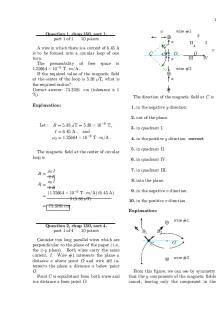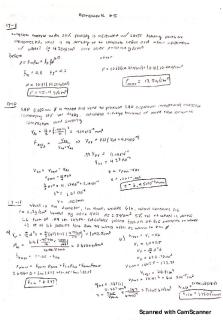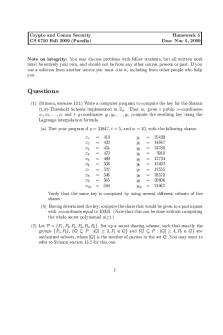Homework 5 PDF

| Title | Homework 5 |
|---|---|
| Author | Madeleine Laibe |
| Course | Intro Astron: Stars and Galaxi |
| Institution | Vanderbilt University |
| Pages | 2 |
| File Size | 78.3 KB |
| File Type | |
| Total Downloads | 18 |
| Total Views | 138 |
Summary
Homework 5 short answers...
Description
1. Describe the star-gas-star cycle 1. A star fuses hydrogen into helium and then helium into carbon. If it is a low-mass star, it stops fusing up to carbon, but high-mass stars can create heavier elements through fusion, up to iron, and their supernova can create up to uranium. These elements are dispersed into the universe once the star ends its life. For a low mass star this is as a planetary nebula leading to a white dwarf and for a high mass star it is a supernova explosion leading to a neutron star or black hole. The interstellar medium, where these elements are dispersed in the universe, then has less hydrogen in proportion to the heavier elements after the supernova explosion or planetary nebula. Once the interstellar medium cools, molecular clouds form and within thee clouds a new star forms that is made out of the material of the interstellar medium. 2. Briefly explain why stars that formed early in history of the galaxy contain a smaller proportion of heavy elements than stars formed more recently. 1. Stars that formed early in the history of the galaxy contain a smaller proportion of heavy elements than stars that formed more recently due to the nature of the star-gasstar cycle. This cycle enriches the galaxy with heavier elements every time a star dies which means the longer time goes on, the more stars that have died and the more heavy elements that have been dispersed into the interstellar medium. Stars that formed more recently come from material that was enriched by many previous supernova explosions and planetary nebula. 3. What produces the striking red, blue, and black colors of ionization nebulae? 1. The single line transition of hydrogen which entails an electron falling from energy level three to energy level two produces an emission line that is responsible for the bright red color. The blue colors are produced from starlight reflecting from dust grains due to that fact that interstellar dust grains scatter blue light more effectively than red light. Black colors are the dark and dense gas clouds that block the view of stars behind them. 4. Explain why spiral arms of spiral galaxies have a blue color. 1. According to the textbook, spiral arms are waves of enhanced density stars and gas in the disk of a galaxy. Since stars are more separated than gas clouds because gas clouds are larger in size, they are not as individually affected by the crowding in a spiral arm. This means that gas clouds suffer from crowding more in the spiral arm and this causes collisions and higher densities which lead to a higher rate of star formation. The higher rate leads to massive stars that are formed to be bluer and brighter than lower mass stars. They do not have time to diffuse across the galactic disk and as a result, they trace the location of the spiral arms which then appear to have a blue color. 5. Describe how we can use the orbital characteristics of stars at many distances fro the galactic center to determine the distribution of mass in the Milky Way, and describe how this has led to the discovery of “dark matter” in our galaxy. 1. The orbital velocity law and its relation to Newton’s version of Kepler’s third law allows us to determine the mass of a galaxy if it lies within a particular radius and we know the average velocity of the stars or clouds that orbit at that radius. We can
determine how much mass of the galaxy lies within each radius if the orbital velocity law is applied to stars orbiting the galactic center. After, we plot the mass of the galaxy as a function of radius and then get the distribution of mass in the Milky way. The 21-cm line from atomic hydrogen is then used to measure the velocities of gas clouds since light at radio wavelets can penetrate dust that would normally keep us from seeing other wavelengths. This allows us to measure the orbital velocities of gas clouds anywhere in the galaxy. We know that the amount of matter in the galaxy is increasing with distance because the orbital velocities of stars and gas in the Milky Way are pretty much constant with increasing distance from the center; basically, the rotation curve of the galaxy is flat. This is true despite the fact that we see less and less stars on the outer rim of the galaxy. Finally, all of this means that there is an existence of vast quantities of dark matter which is mass that we are aware of but cannot see. 6. See Worksheet 7. Summarize (donʹt merely list) the steps in the ʺcosmological distance ladderʺ that allow us to estimate distances to the farthest reaches of the universe. Give them in order (from nearest to farthest) of the distances that can be measured by them. Say how each subsequent step depends on the previous step. 1. According to the textbook, the first step is measuring the distance to the Sun through radar ranging. Once we have this distance, stellar parallax is used to measure the distances of the nearest stars. Stellar parallax is the way we measure the distance of Hyades, which is an open cluster. This cluster of stars is then plotted on the H-R diagram in order to determine their luminosity on the main sequence. More distance clusters are also plotted to compare their main sequence to that of the stars from the Hyades cluster and measure their distance through main-sequence fitting. This is how the distances to Cepheid variable in the clusters are determined and since there is a period-luminosity relationship for Cepheid, their distances to other Cepheids can be measured by comparing the time periods between peaks of brightness. Cepheid variables are so bright that they can be seen in other galaxies so they act as standard candles in other galaxies. White dwarf supernova are also very bright, brighter than cepheid variables, and can be used to determine the distance of another galaxy along with the Tully-Fisher relation. Both are far enough away from the Milky Way that Hubble’s Law can be calibrated by determining the Hubble constant and this allows us to determine a galaxy’s distance from its redshift. 8. See Worksheet...
Similar Free PDFs

Homework 5
- 2 Pages

Homework 5
- 9 Pages

Homework 5
- 4 Pages

Hoework 5 - homework 5
- 3 Pages

Homework 5
- 2 Pages

HW 5 - Week 5 homework
- 6 Pages

Chapter 5 HW - Homework
- 2 Pages

5 - online homework solution
- 8 Pages

Seminar assignments - Homework 5
- 1 Pages

Hw 11-5 - Homework
- 2 Pages

Hw #5 - homework
- 4 Pages

homework 5 for cs240
- 6 Pages

Homework-5-sln - HW5
- 4 Pages

Homework Chapter 5
- 4 Pages

Unit 5 Homework
- 3 Pages

Homework Solution 5
- 3 Pages
Popular Institutions
- Tinajero National High School - Annex
- Politeknik Caltex Riau
- Yokohama City University
- SGT University
- University of Al-Qadisiyah
- Divine Word College of Vigan
- Techniek College Rotterdam
- Universidade de Santiago
- Universiti Teknologi MARA Cawangan Johor Kampus Pasir Gudang
- Poltekkes Kemenkes Yogyakarta
- Baguio City National High School
- Colegio san marcos
- preparatoria uno
- Centro de Bachillerato Tecnológico Industrial y de Servicios No. 107
- Dalian Maritime University
- Quang Trung Secondary School
- Colegio Tecnológico en Informática
- Corporación Regional de Educación Superior
- Grupo CEDVA
- Dar Al Uloom University
- Centro de Estudios Preuniversitarios de la Universidad Nacional de Ingeniería
- 上智大学
- Aakash International School, Nuna Majara
- San Felipe Neri Catholic School
- Kang Chiao International School - New Taipei City
- Misamis Occidental National High School
- Institución Educativa Escuela Normal Juan Ladrilleros
- Kolehiyo ng Pantukan
- Batanes State College
- Instituto Continental
- Sekolah Menengah Kejuruan Kesehatan Kaltara (Tarakan)
- Colegio de La Inmaculada Concepcion - Cebu